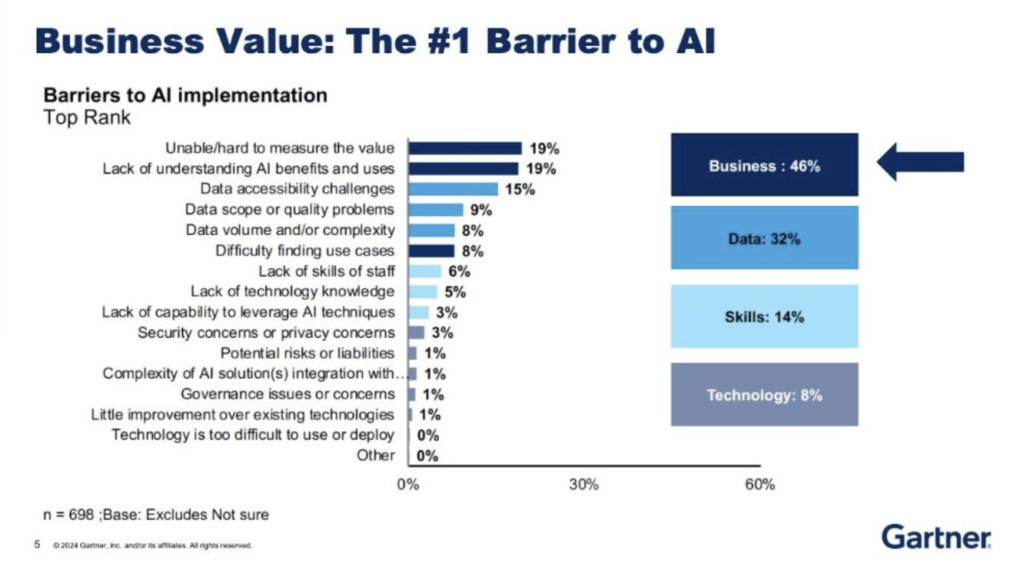Make no mistake, AI adoption is moving faster than any other technological breakthrough we’ve ever lived through. You may be aware that ChatGPT set the record for the fastest-growing digital product of all time—reaching 100 million users in just 2 months. We’ve watched as AI has taken over much of our social conversation—just look at the growth in Google searches for AI in the past 5 years. They have exploded. Undoubtedly, AI Is taking the business world by storm.
We have witnessed a new, accelerated shift over the past 6-9 months. Organizations have moved from what I call paralyzed curiosity to active experimentation. Whereas last summer, organizations were talking about AI, seeking to understand, grappling for use cases, and being nervous they were behind, they are now starting to take action. They are finding low-hanging fruit and working to incorporate AI into their existing processes and procedures. And, with that experimentation, we are beginning to see an explosion in the proverbial “ROI” question. In fact, according to a recent Gartner study, being “Unable/hard to measure the value” is currently the #1 barrier to AI adoption.

Measuring the ROI of AI Isn’t an Exact Science
On a recent episode of the AI Knowhow podcast, we spoke about the challenges of measuring the ROI of AI. We had one of our most spirited discussions out of any episode so far, and we concluded that, undoubtedly, it’s difficult to measure, but that doesn’t mean you should be paralyzed. Developing a hypothesis of where the ROI will come from and measuring your success is the fastest way to learn. (Mohan hit me with a few jabs in the episode like the one below that I still need to get him back for…)
Understanding Incremental vs. Transformative Innovation
Looking at incremental vs. transformative innovation is a good place to start to understand where we are with deriving ROI from AI.
When a new invention first becomes available, as adoption spreads, businesses tend to look to improve the status quo first. We optimize existing processes and tweak them around the edges. In the early days of the internet and mobile, it was common practice for companies to duplicate physical experiences in the digital world. Yes, there may be an app for that, whatever that is, but…should there be?
Due to the incremental nature of these changes, we tend to believe we should be able to measure the expected improvement and quantify the cost of the improvement. Unfortunately, in the early days, neither is certain because we are so early in the lifecycle.
This is the point at which we sit with AI today. We are unable to know, with the certainty typically expected of an ROI calculation, what the transaction costs of our AI queries and the fidelity of our solutions will be. ROI is very difficult to measure.
While incremental innovation first hits the public’s eye, inevitably, ideas begin to emerge about how we can rethink an entire ecosystem. It’s critical to remember that disruptive innovation is not about processes and technology. True disruptive innovation drives a fundamental change in the economics of an industry. It disrupts the status quo within a business and throughout an entire sector.
Take, for example, the internet. Yes, the internet undoubtedly optimized how data packets were transferred from one computer to another. Yet, it also enabled massive economic disruption. The publishing, commerce, and software industries were turned upside down. Distributors were cut out, and direct-to-consumer models popped up everywhere.
Putting the AI Timeline and ROI in Context
The underlying protocol behind the internet (TCP/IP) was established in the 1970s and adopted as the standard for ARPANET in 1983. In 1991, AOL launched, which democratized internet access. It wasn’t until Amazon launched in 1995 that we saw transformative B2C digital business models emerge. Likewise, Salesforce launched in 1999.
Arguably, Amazon (for B2C companies) and Salesforce (for B2B companies) pioneered business models that disrupted their spaces. These companies, alongside eBay (1995), Google (1998), and Facebook (2004) became the impetus behind massive trends that ripped through our entire economy. (As an interesting aside, more than 10% of Amazon’s revenue and as much as 70% of its profit now comes from AWS. Talk about disrupting yourself…)
It’s critical to remember that we are still in the earliest phases of AI adoption. I would argue that ChatGPT is analogous to AOL, democratizing Artificial Intelligence and putting it on the map. In other words, with AI, we’re still on the equivalent of dial-up modems. The Amazons, Salesforces, eBays, Googles, and Facebooks of the world haven’t even been born yet. With any luck, in the next few years they will be.


